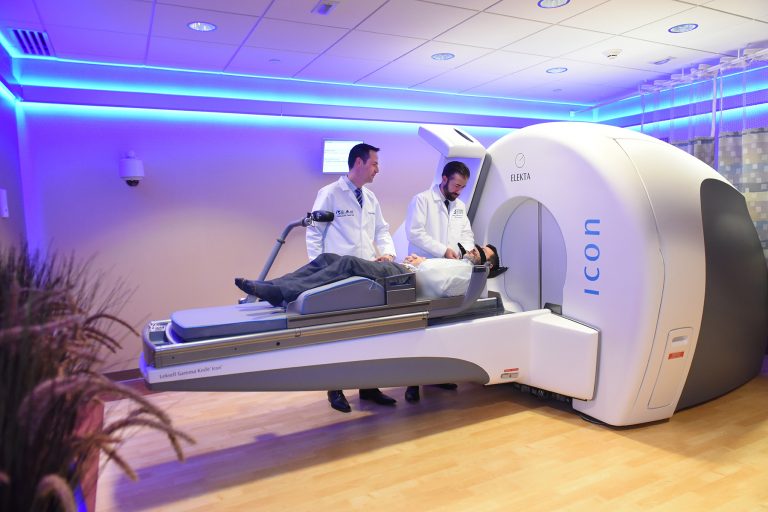If you’ve recently been diagnosed with a condition of the brain or head, it is likely your doctor has recommended stereotactic radiosurgery as a treatment option.
Gamma Knife and CyberKnife are two popular forms of stereotactic radiosurgery and while they are similar, there are differences to consider when choosing the right treatment option for you. Read on to learn more about Gamma Knife vs CyberKnife.
Ready to take the next step?
Speak online with our medical director.
Schedule Now
Ready to take the next step?
Speak online with our medical director.
Schedule Now
What is Gamma Knife?
Though the name may sound like a surgical procedure, Gamma Knife is actually an advanced form of radiation therapy that uses multiple focused beams of high dose radiation to target a highly specific area.
Because it is so focused, Gamma Knife does not affect as much of the surrounding tissue as traditional radiation therapy, such as whole-brain radiation, resulting in fewer side effects. Additionally, because it is completely non-invasive, it does not carry any of the risks associated with traditional surgery, has less post-procedural pain and has a minimal recovery period.
What is CyberKnife?
CyberKnife treats tumors by focusing photons (X-rays) at the tumor. It may reduce or eliminate a tumor in just a few treatment sessions.
The CyberKnife machine has a robotic arm that is able to move around the patient, accessing the tumor from different angles which increases the number of positions that it can administer radiation to the treatment area. This also minimized dose to healthy tissue surrounding the treatment area.
5 Ways That Gamma Knife Is Different From Cyberknife
Let’s start by stating that both Gamma Knife (GKRS) and Cyberknife are amazingly safe and accurate options for anyone who needs stereotactic radiosurgery. At the end of the day, as long as your expert team has a good safety record and superior outcomes, both radiosurgery options are excellent. That said, the platforms do have their differences and knowing them might help you make a more informed treatment decision.
1. Specificity for the Brain
Both technologies deliver stereotactic radiosurgery to treat cancerous and noncancerous tumors. Both procedures are performed as an outpatient and are considered minimally invasive. However, Gamma Knife is highly targeted and designed specifically for the brain – and when it comes to the brain, precision is critical.
2. Gamma Knife was invented in 1968
“The first Leksell Gamma Knife stereotactic radiosurgery procedure in a clinical setting was performed in Stockholm on January 27, 1968. By 2018 — Gamma Knife® Radiosurgery’s 50th year — 1.1 million people around the world have received the therapy.” Being that GKRS has been around for more than 50 years, the amount of data that is available is extensive. Patients treated with Gamma Knife can read about the safety and long-term effects of Gamma Knife Radiosurgery knowing that the information is robust and accurate.
3. Cyberknife was introduced in 1994
“The CyberKnife was invented at Stanford Health Care and first debuted in 1994. Twenty years ago, the CyberKnife revolutionized cancer care by reducing treatment time and treating previously inoperable tumors. In 2014, CyberKnife inventor, John Adler, MD, along with his Stanford colleagues, celebrated the 20th anniversary of this groundbreaking technology.” Cyberknife has also been around for quite some time and has a great track record for treating tumors throughout the body in 1-5 sessions.
4. Head Frame or Mask – Comfort Is The Question
Another distinguishing factor between the two options is the mobility of the patient during the procedure. When undergoing most Gamma Knife procedures, the patient is placed in a head frame, to ensure no movement in order to dose the radiation as accurately as possible. With the advent of the new Gamma Knife ICON, however, a mask option is now available and being used throughout the world. When undergoing CyberKnife, a well-fitted, non-rigid mask is used instead of a head frame.
5. Length and Number of Sessions per Treatment
Risks and side effects for both treatments are similar, as they are both minimally invasive forms of stereotactic radiosurgery. While Gamma Knife is generally treated in as little as one treatment session, CyberKnife is typically completed in 1-5 sessions that are spread out over a few weeks. This could be a hardship on some patients.
Overview of Gamma Knife vs CyberKnife
CyberKnife is a more recent invention than Gamma Knife Radiosurgery and seems to be more comfortable for patients, but Gamma Knife is typically done in fewer sessions and delivers higher accuracy, in our view. Both have been used by neurosurgeons in recent years and are viable treatment options.
Next Steps
If your doctor has recommended Gamma Knife as a treatment for your condition, contact The Valley Gamma Knife Center to learn more about our state-of-the-art Gamma Knife technology and if it is right for you. A Nurse Navigator will be happy to assist you.
Call to see if Gamma Knife is an option for you: 201-634-5610


